
119
HNUE JOURNAL OF SCIENCE
Educational Sciences 2024, Volume 69, Issue 3, pp. 119-130
This paper is available online at https://hnuejs.edu.vn
DOI: 10.18173/2354-1075.2024-0053
THE CURRENT SITUATION OF APPLYING GROUP TEACHING METHOD
IN GEOGRAPHY EDUCATION IN HIGH SCHOOLS IN THANH HOA PROVINCE
Thieu Thi Thuy1* and Ngo Thi Hai Yen2
1Faculty of Social Sciences, Hong Duc University, Thanh Hoa province, Vietnam
2Faculty of Geography, Hanoi National University of Education, Hanoi city, Vietnam
Corresponding author: e-mail: thieuthithuy@hdu.edu.vn
Received May 14, 2024. Revised June 18, 2024. Accepted July 12, 2024.
Abstract. Group teaching methods play an important role in developing collaboration and
problem-solving ability in competency-based education. The study of the current status of
using the group teaching method in Geography in high schools has many practical meanings
and helps to improve the teaching quality in general and Geography teaching quality in
particular. The article carried out a survey with in-depth interviews combined with
distributing questionnaires to 20 Geography teachers at 15 high schools and 600 students at
5 high schools in Thanh Hoa province. The results show that: 1. Teaching in groups is the
top choice for innovative teaching methods in Geography but is not used regularly in lessons
to form knowledge and skills.; 2. A number of high school students are quite interested in
group work and aware of the role and meaning of group activities; 3. The use of the group
teaching method in Geography teaching still has limitations and has not been highly effective.
This result can be used to propose solutions to improve teaching quality and renovate
teaching methods to meet the requirements of the 2018 General Education Program.
Keywords: group teaching method, Geography, high school, Thanh Hoa.
1. Introduction
In the process of global integration, the education system of Vietnam has been undergoing
many changes by worldwide trends. The motto of fundamental and comprehensive innovation in
education has required not only changes in programs but also renovations in teaching methods
and ways of evaluating students [1]. The 2018 General Education Program (hereinafter referred
to as the New Education Program) was performed when the Vietnamese education system
was confronting an alter within the drawing closer mentality from content-based instruction to
competency-based education for students [2]. Encouraging the positiveness of learners is a
significant change in the present educational advancement. This matter has been investigated by
numerous scientists and educators all over the country [3]. The tendency of modernizing teaching
methods to improve learners’ capabilities requires teachers to encourage students to actively study
and develop their qualities, and general and specific competencies [4]. On the other hand, teachers
have to modify their teaching approaches that meet students’ needs to maximize the effectiveness
of the learning process [5]. The New Education Program has also determined the general
competencies of school subjects that need to be improved for students, including communication

Thieu TT* & Ngo THY
120
and collaboration capacity [6]. These two competencies define the ability to solve difficulties
through teamwork.
With the organization of learning for students to carry out group tasks, the group teaching
method has many advantages in developing communication, collaboration, and problem-solving
skills for learners [7]. Besides, various investigations of teaching methods confirm that
collaborative activities generate a happy learning atmosphere, encourage students’ incentives, and
create an environment to practice communication skills while consolidating and raising
vocabulary, ideas, and fluency [8]. Furthermore, studying by the group presentation technique,
pupils have improved their language ability clearly and gained better results than in traditional
learning. And, their attitude to applying communication skills was also increased [9]. Working in
small groups gives students the chance to clarify concepts and ideas, expose presumptions and
misunderstandings, and bargain with others to generate products or come to an agreement.
Through teamwork, students can develop their critical thinking abilities and uncover deeper
significance in the material. When students are engaged with a higher-level subject that is
challenging to understand, has multiple interpretations, or raises critical thinking, group work is
most beneficial [10]. A well-planned small group teaching session offers both teachers and
students a methodical approach. Successful small-group teaching and learning techniques boost
student engagement, information retention, self-directed learning, communication skills,
teamwork capacity, and peer debate as compared to didactic classes [11]. Student participation
and discussion are effectively encouraged in small-group instruction. Teaching strategies for
small groups can be employed by teachers to support learning in a variety of contexts. [12]. The
most crucial elements of successful small groups, according to the students, are tutor qualities, a
welcoming environment, clinical relevance and integration, and instructional resources that
promote independent thought and problem-solving [13].
In Vietnam, teaching methods in Geography are frequently discussed in studies on the theory
and methodology of the subject. Notable works include those by Le T, Nguyen MT (2018), Le T
(2019), Pham HT, Nguyen VT (2019), Ngo THY, Nguyen TD, Dang TD, Nguyen D, Nguyen TP
(2012), and Dang VD, Nguyen TH (2003) ([14], [15], [16], [17], [18]). These studies have
addressed fundamental theoretical issues, paving the way for the implementation of positive
teaching approaches. Recently, training documents of the Ministry of Education and Training
have also mentioned how to implement innovation in teaching methods towards capacity
development, with a focus on identifying several competencies and guidance to build lesson plans
and use modern teaching methods and techniques. There are also some studies on teaching
methods in Geography by authors such as Trinh CT, Phan HL, and Trinh VT (2023), Nguyen TL
(2019), Hoang TTHG, (2019), Nguyen TL, (2019), Hoang Thi T, (2023), Nguyen TX (2019),
Nguyen VT (2019) and Doan TTP (2020) ([19], [20], [21], [22], [23], [24], [25], [26]). Group the
teaching method is exercised in different forms, scopes, and levels in Geography. With its
characteristics, Geography has a great deal of conditions to apply this method to encourage
students' activity, initiative, cooperation, and creativity; in that way, developing their capacities.
This method in many cases can generate advantages for teachers and students to effectively
exploit modern teaching facilities and equipment [17]. However, using the group teaching method
in practice still has limitations that come from not clearly understanding the nature of the method.
For instance, when applying the group teaching method, teachers normally focus on designing
assignments that complete the goal of knowledge and skills without paying attention to building
up problem-solving capacity [7]. The exercise of this method in a formal, inflexible, and useless
way has led to group work becoming the activities of a few individuals in the class [27]. Thereby
they raise man y questions: Is teaching in groups the best choice to develop students' capacity in
Geography? What is the real situation of using the group teaching method in high schools today?
Is the application of the group teaching method truly output-oriented for educational improvement
or is it just a formal but ineffective response?

The current situation of applying group teaching method in Geography education in high schools…
121
From those concerns, the author chose the topic “The current situation of using the group
teaching method in Geography teaching in high schools in Thanh Hoa province” as the study
content. In Geography teaching, this is a research direction with much practical significance for
the successful implementation of the 2018 General Education Program.
2. Content
2.1. Methodology
2.1.1. Survey and investigation method
The main research method of the study is quantitative research with survey design combined
with qualitative interviews. The author directly conducted in-depth interviews with 10 teachers
who are teaching Geography at 5 high schools in plain and coastal areas of Thanh Hoa province:
Hoang Hoa 3 High School, Nong Cong 2 High School, Trieu Son 3 High School, Tinh Gia 2 High
School and Nga Son High School. These are schools randomly selected to conduct surveys for
the study. In addition, the author sent survey questionnaires (via email) to 10 Geography teachers
at the other 10 high schools in the hilly and mountainous areas of the province to have more
comprehensive and objective data for the study.
As for students, the author went to classrooms and distributed questionnaires to students in
the above 5 high schools to find out the real situation and effectiveness of performing group
teaching method in Geography. The survey subjects were mainly students in grades 10 and 11, in
general classes, without selective or gifted students.
The questionnaire is designed with a structure of both closed questions and open questions.
The survey was conducted in one round and had no pedagogical impact.
The author used the formula to calculate the sample size of the study in case the population
is unknown: 𝑛 = 𝑧2(𝑝×𝑞)
𝑒2
In which:
- n is the sample size
- z is the distribution value corresponding to the selected confidence level. If the confidence
level is 95%, the z value is 1.96
- p is the estimated proportion of the population
- q is: 1- p
The ratio of p and q is often estimated to be 50%/50%, which is the maximum possible for
the population.
- e is the tolerance. In this study, e = ± 4%
The sample size 𝑛 = 1.962(0.5×0.5)
0.042=600.25
So, the total number of survey questionnaires of the study are 600, including:
- Plain area: 240 questionnaires (including Nong Cong 2 High School and Trieu Son 3 High
School, 120 questionnaires for each school).
- Coastal area: 360 questionnaires (including Hoang Hoa 3 High School, Tinh Gia 2 High
School, and Nga Son High School, 120 questionnaires for each school).
2.1.2. Mathematical statistical method
This is the second important method that directly clarifies the results of the study. Data for
this study was mainly collected from 600 survey questionnaires of students and 20 survey
questionnaires of teachers. Collected data was then analyzed and calculated by SPSS and Excel
software into figures. These figures were then classified and processed into tables and charts by
using mathematical and statistical formulas.

Thieu TT* & Ngo THY
122
2.1.3. Literature review method
To carry out the study, the author has collected information from many different documents
in Vietnam and the world related to group teaching methods. This method mainly serves the
introduction and causes of the current situation part of the study.
2.1.4. Observation method
The author carried out observations of some Geography lessons using the group teaching
method in high schools to have a practical view and make accurate and objective assessments.
This method only makes a small contribution to objectively analyzing the current situation by
applying the group teaching method, and observation is only performed subjectively without tools
(checklists, observation sheets...).
2.2. Study results
2.2.1. Real-life situation of using group teaching method in Geography in high schools of
Thanh Hoa province
Group work is a frequently used method in teaching at high schools in general and in
teaching Geography in particular. According to the survey of 20 Geography teachers, 100% are
aware of the innovation in teaching methods towards developing learner capacity with the
application of many specific teaching methods, including teaching in groups. This is the most
chosen method among other active methods in renovating Geography teaching. Nonetheless,
about 60% of teachers do not use group teaching regularly in lessons that form knowledge and
skills, but use it in lessons related to practice and review. 30% of teachers rarely or never use the
group teaching method except for observing classes.
Data from the students' survey shows that about 25.6% of Geography lessons use group work
as illustrated in Figure 1 below:
Figure 1. Activities in the Geography lesson
Surveyed students answered that in Geography classes, the activities they participate in the
most are individual activities (48.3%) and whole class activities (26.1%). For Geography classes
with group work, each group usually has more than 10 members (46%), students elect a group
leader, and a secretary, and divide tasks among group members (80.5%). This data also matches
the feedback of the interviewed teachers.
Only 10% of Geography teachers said that they have been teaching in groups quite often in
their classes for various reasons. For instance, this method helps students easily express their
personal opinions, exchange, discuss, and come up with solutions for assigned tasks; through
teamwork, students can actively receive knowledge, improve their thinking and judgment, and so
on. However, collected data from the survey questionnaires proves the fact that only 48.77% of
high school students like group activities in Geography (Figure 2). The rest choose to learn
individually and solve given tasks by themselves.
25.60%
48.30%
26.10%
Group activity
Individual
activity
Whole class
activity

The current situation of applying group teaching method in Geography education in high schools…
123
Figure 2. Students' interest in Geography lesson activities
50% of the surveyed teachers have been applying the group teaching method with different
teaching techniques such as tablecloth technique, fishbowl technique, gallery technique, puzzle
piece technique, stage technique, etc. These are also positive teaching techniques that can create
excitement in learning and promote the abilities of learners.
According to the results of teacher interviews and surveyed students’ answers, when teaching
in groups, Geography teachers often use modern teaching facilities and equipment like projectors
and internet-connected TVs to assign tasks for students, mainly to present study sheets, maps,
diagrams, charts, data tables, videos, images, geographical events, and phenomena. Teachers
(90%) often require their students to work in teamwork with dissimilar tasks in Geography
lessons, making peer assessment difficult because students normally focus on solving problems
of their group without understanding other groups’ assignments.
In group activities, Geography teachers do not often change students in groups but use
previous groups to save time (80%) and evaluate students' capacity through their products, their
presentation of results, or study cards. Additionally, many teachers (90%) carry out peer
assessments by asking students to comment on their peer reports. This information matches most
of the answers of the surveyed students (with open questions).
2.2.2. The effectiveness of using the group teaching method in Geography at high schools of
Thanh Hoa province
The results from the survey are shown in the following tables:
Table 1. Students’ participation level in group activities during Geography class
Participation of students
Frequency (%)
Mean
Standard
deviation
1
2
3
4
5
Students actively participate in
group discussions and contribute
ideas.
2.18
10.35
35.15
44.96
7.36
3.45
0.86
Students want to present the report
of their group discussion.
10.35
20.71
43.60
17.44
7.9
2.92
1.05
Students are aware that participating
in group activities is the
responsibility of all members.
2.2
3.16
11.21
34.11
48.32
4.2
0.93
The group leader clearly assigns
tasks to group members.
4.16
6.93
19.94
42.11
26.87
3.81
1.04
Students use information in
textbooks to solve group
assignments.
2.21
4.14
19.06
51.38
23.20
3.89
0.88
48.77%
16.39%
34.84% Group activity
Individual activity


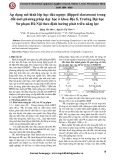
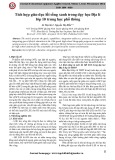
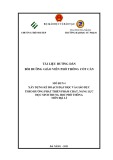
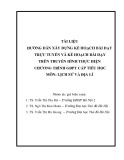


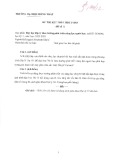



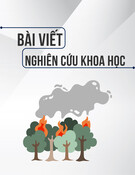
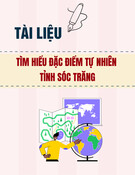
![Quy hoạch tổng thể Cà Mau: Tài liệu [mới nhất/chuẩn nhất]](https://cdn.tailieu.vn/images/document/thumbnail/2025/20250827/tghong1621@gmail.com/135x160/49401756278390.jpg)

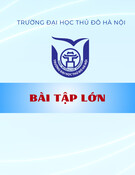
![Bài giảng Hàng hải địa văn [chuẩn nhất]](https://cdn.tailieu.vn/images/document/thumbnail/2025/20250729/vijiraiya/135x160/43361753782101.jpg)
![Bài giảng Trắc địa cơ sở [mới nhất]](https://cdn.tailieu.vn/images/document/thumbnail/2025/20250729/vijiraiya/135x160/84_bai-giang-trac-dia-co-so.jpg)
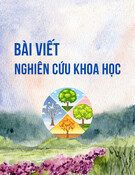




![Atlas tài nguyên nước Việt Nam: Tài liệu [Mô tả/Hướng dẫn/Chi tiết]](https://cdn.tailieu.vn/images/document/thumbnail/2025/20250715/vijiraiya/135x160/348_tai-lieu-atlas-tai-nguyen-nuoc-viet-nam.jpg)
![Hệ thống câu hỏi ôn tập Vùng kinh tế [chuẩn nhất]](https://cdn.tailieu.vn/images/document/thumbnail/2025/20250709/kimphuong1001/135x160/76921752140578.jpg)
